Work And Energy: Learning objectives
At the end of this chapter the students will be able to:
- Understand the concept of work in terms of the product of a force and displacement in the direction of the force.
- Understand and derive the formula work = wd = mgh for work done in a gravitational field near Earth’s surface
- Understand that work can be calculated from area under the force-displacement graph.
- Relate power to work done.
- Define power as the product of force and velocity.
- Quote examples of power from everyday life.
- Explain the two types of mechanical energy.
- Understand the work-energy principle.
- Derive an expression for absolute potential energy.
- Define escape velocity.
- Understand that in a resistive medium loss of potential energy of a body is equal to gain in kinetic energy of the body plus work done by the body against friction.
- Give examples of conservation of energies from everyday life.
- Describe some non-conventional sources of energy.
Work is often thought in terms of physical or mental effort. In physics, however , the term work involves two things (i) force (ii) displacement . we shall begin with a simple situation in which work is done by a constant force.
4.1 work done by a constant force
Let us consider an object which is being pulled by a constant force F at an angle θ to the direction of motion. The force displaces the object from position A to B through a displacement d (Fig. 4.1).

We define work W done by the force F as the scalar product of F and d.
W = F.d = Fd cos θ …………. (4.1)
= (F cosθ) d
The quantity (F cosθ) is the component of the force in the direction of the displacement d.
The , the work done on a body by a constant force is defined as the product of the magnitudes of the displacement and the component of the force in the direction of the displacement.
Can you tell how much work is being done?
(i) One the pail when a person holding the pail by the force F is moving forward (Fig. 4.2 a).
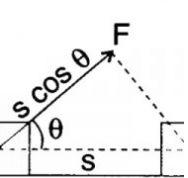
(ii) On the wall (Fig. 4.2 b)?
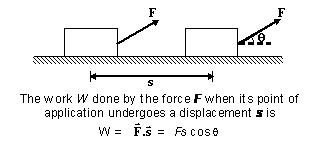
When a constant force acts through a distance d, the event can be plotted on a simple graph (fig. 4.3). the distance is normally plotted along x-axis and the force along y-axis. In this case as the force does not vary, the graph will be a horizontal straight line, if the constant force F (newton) and the displacement d (metre) are in the same direction then the work done is Fd (joule). Clearly shaded area in fig. 4.3 is also Fd. Hence the area under a force- displacement curve can be taken to represent the work done by the force. In case the force F is not in the direction of displacement, the graph is plotted between F cos θ and d.
From the definition of work, we find that:
(i) Work is a scalar quantity.
(ii) If θ < 90⁰, work is done and it is said to be positive work.
(iii) If θ = 90⁰, no work is done.
(iv) If θ > 90⁰, the work done is said to be negative.
(v) SI unit of work is N m known as joule (J).
Work Done By A Variable Force
In many cases the force does not remain constant during the process of doing work. Fro example, as a rocket moves away from the earth, work is done against the force of gravity, which varies as the invers square of the distance spring increase with the amount of sttetch. How can we calculate the work done in such a situation?
Fig. 4.4 shows the path of a particle in the x-y plane as it moves from point a to point b. the path has been divided into n short intervals of displacements and ![]() are the forces acting during these intervals.
are the forces acting during these intervals.

During each small interval, the force is supposed to be approximately constant, so the work done for the first interval can then be written as
And so on. The total work done in moving the object can be calculated by adding all these terms. 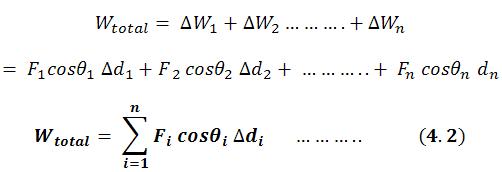 We can examine this graphically by plotting f cosθ verses d as shown in Fig. 4.5. the displacement d has been subdivided into n equal intervals. The value of F cos0 at the beginning of each interval is indicated in the figure.
We can examine this graphically by plotting f cosθ verses d as shown in Fig. 4.5. the displacement d has been subdivided into n equal intervals. The value of F cos0 at the beginning of each interval is indicated in the figure.
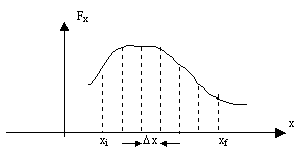
Now the ith shaded rectangle has an area ![]() which is the work done during the ith interval. Thus, the work done given by Eq. 4.2 equals the sum of the areas of all the rectangles. Of we subdivide the distance into a large number of intervals so that each ∆d becomes very small, the work done given by Eq. 4.2 becomes more accurate. If we let each ∆d to approach zero then we obtain an exact result for the work done, such as
which is the work done during the ith interval. Thus, the work done given by Eq. 4.2 equals the sum of the areas of all the rectangles. Of we subdivide the distance into a large number of intervals so that each ∆d becomes very small, the work done given by Eq. 4.2 becomes more accurate. If we let each ∆d to approach zero then we obtain an exact result for the work done, such as
 In this limit ∆d approaches zero, the total area of the rectangles (fig. 4.5) approaches the area between the F cos0 curve and a’axis from a to b as shown shaded in fig. 4.6.
In this limit ∆d approaches zero, the total area of the rectangles (fig. 4.5) approaches the area between the F cos0 curve and a’axis from a to b as shown shaded in fig. 4.6.

Thus, the work done by a variable force in moving a particle between two points is equal to the area under the F cos θ verses d curve between the two points a and b as shown in Fig. 4.6.
Example: 4.1: a force F acting on an object varies with distance x as shown in Fig. 4.7. calculate the work done by the force as the object moves from x = 0 to x = 6 m.

Solution: The work done by the force is equal to the total area under the curve from x = 0 to x = 6 m. this area is equal to the area of the rectangular section from x = 0 to x = 4 m, plus the area of triangular section from x = 4 m to x =6 m. Hence
Work done represented by the area of rectangle = 4m x 5 N
= 20 Nm = 20 J
Work done represented by the area of triangle = ½ x 2m x 5N
= 5 N m= 5 J
Therefore, the total work done = 20 J + 5 J = 25 J
Work done by gravitational field
The space around the earth in which its gravitational force acts on a body is called the gravitational field. When an object is moved in the gravitational field, the work is done by the gravitational force. If displacement is in the direction of gravitational force, the work is positive. If the displacement. Is against the gravitational force, the work is negative.
Let us consider an object of mass m being displaced with constant velocity from point A to B along various paths in the presence of a gravitational force (Fig. 4.8). in this case the gravitational force is equal to the weight mg of the object.
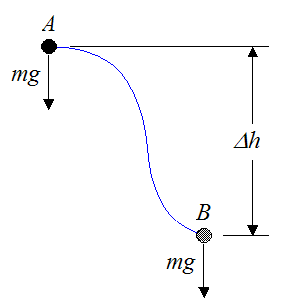
The work done by the gravitational force along the path ADB can be split into two parts. The work done along AD is zero, because the weight mg is perpendicular to this path, the work done along DB is (-mgh) because the direction of mg is opposite to that of the displacement i.e. θ = 180⁰. Hence, the work done in displacing a body from A to B through path 1 is
WADB = 0 + (- mgh) = -mgh
If we consider the path ACB, the work done along AC is also (-mgh). Since the work done along CB is zero, therefore,
W ACB = -mgh + 0 = -mgh
Let us now consider path 3, i.e. a curved one. Imagine the curved path, the be broken down into a series of horizontal and vertical steps as shown in Fig. 4.9. there is no work done along the horizontal steps, because mg is perpendicular to the displacement for these steps. Work is done by the force of gravity only along the vertical displacements.
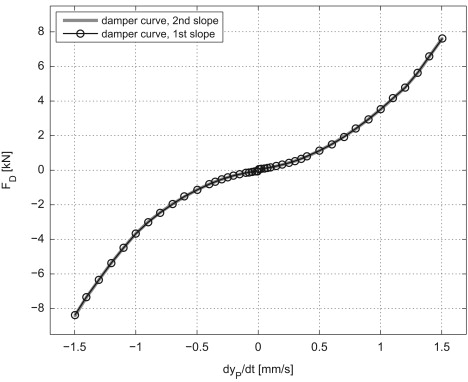
The net amount of work done along AB path is still (-mgh).
We conclude from the above discussion that.
Work done in the earth’s gravitational field is independent of the path followed.
Can you prove that the work done along a closed path such as ACBA or ADBA (Fig. 4.8), in a gravitational field is zero?
The field in which the work done be independent of the path followed or work down in a closwd path be zero, is called a conservative filed.
The frictional force is a non-conservative force, because if an object is moved over a rough surface between two points along different paths, the work donw against the frictional force certainly depends on the path followed.
Power
In the definition of work , it is not clear, whether the same amount of work is done in own second or in one hour. The rate, at which work is done, is often of interest in practical applications.
Power is the measure of the rate at which work is being done.
If work ∆W is done in a time interval ∆t, then the average power Pav during the interval ∆t is defined as

If work is expressed as a function of time, the instantaneous power P at any instant is defined as
Where ∆W is the work done in short interval of time ∆t following the instant t.
|
For your information |
|
Conservative forces Gravitational force Elastic spring force Electric force
Non conservative forces Frictional force Air resistance Tension is a string Normal force Propulsion force of a rocket Propulsion force of a motor |
Power and velocity
It is , sometimes, convenient to express power in terms of a constant force F acting on an object moving at constant velocity v. for example, when the propeller of a motor boat causes the water to exert a constant force F on the boat, it moves with a constant velocity v. the power delivered by the motor at any instant is, the, given by

The Si unit of power is watt, defined as one joule of work done in one second.
Sometimes, for example, in the electrical measurements, the unit of work is expressed as watt second. However, a commercial unit of electrical energy is kilowatt-hour.
One kilowatt hour is the work done in one hour by an agency whose power is one kilowatt.
Therefore, 1 kWh = 1000 W x 3600 s.
Or 1 kWh = 3.6 x 106 j = 3.6 M J

Example 4.2: A 70 kg man runs up a long flight of stairs in 4.0 s. the vertical height of the stairs is 4.5 m. calculate his power output in watts.
Solution: work done = mgh

Potential Energy
Energy of a body is its capacity to do work. There are two basic forms of energy.

(i) Kinetic energy (ii) potential energy
The kinetic energy is possessed by a body due to its motion and is given b the formula
Where m is the body moving with velocity V.
The potential energy is possessed by a body because of its position in a force field e.g. gravitational field or because of its constrained state the potential energy due to gravitational field near the surface of the earth at a height H is given by the formula
P.E. = mgh …………….. (4.8)
This is called gravitational potential energy. The gravitational P.E. is always determined relative to some arbitrary position which is assigned the value of zero P.E. in the present case, this reference level is the surface of the earth as position of zero P.E. in some cases a point at infinity from the earth can also be chosen as zero reference level.
The energy stored in a compressed spring is the potential energy possessed by the spring due to its compressed or stretched state. This form of energy is called the elastic potential energy.

Work-energy principle
Whenever wor is doen on a body, it increases its energy. For example a body of mass m is moving with velocity Vi. A force F acting through a distance d increases the velocity to Vi then from equation of motion

| Tid-bits |
| All the food you eat in one day has about the same energy as 1/3 liter of petrol. |
Where the left hand side of the above equation gives the work done on the body and rith hand side gives the increase or change in kinetic energy of the body. Thus
Work done on the body equals the change in its kinetic energy.
This is known as work –energy principle. If a body is raised up from the earth’s surface, the work done changes the gravitational potential energy similarly, if a spring is compressed, the work done on it equals the increase In its elastic potential energy.
Absolute potential energy:
The absolute gravitational potential energy of an object at a certain position is the work done by the gravitational force in displacing the object from that position to infinity where the force of gravity becomes zero.
The relation for the calculation of the work done by the gravitational force of potential energy = mgh, is true only near the surface of the earth where the gravitational force is nearly constant. But if the body is displaced through a large distance in space from, let, point 1 to N ( Fig. 4.10) in the gravitational field, then the gravitational force will not remain constant, since it varies inversely to the square of the distance.
In order to overcome this difficulty, we divide the distance between points 1 and N into small steps each of length ∆r so that the value of the force remains constant for each small step. Hence, the total work done can be calculated by adding the work done during all these steps. If r1 and r2 are the distances of points 1 and 2 respectively, from the center O of the earth (fig. 4.10), the work done during the first step i.e., displacing a body from point 1 to point 2 can be calculated as below.

The distance between the centre of this step and the center of the earth will be

The gravitational force F at the centre of this step is
![]() Where m = mass of an object , M = mass of the earth and G = gravitational constant.
Where m = mass of an object , M = mass of the earth and G = gravitational constant.
Squaring Eq. 4.12

Do You know?

As this force is assumed to be constant during the interval ∆r, so the work done is
Absolute potential energy:
The absolute gravitational potential energy of an object at a certain position is the work done by the gravitational force in displacing the object from that position to infinity where the force of gravity becomes zero.
The relation for the calculation of the work done by the gravitational force of potential energy = mgh, is true only near the surface of the earth where the gravitational force is nearly constant. But if the body is displaced through a large distance in space from, let, point 1 to N ( Fig. 4.10) in the gravitational field, then the gravitational force will not remain constant, since it varies inversely to the square of the distance.
In order to overcome this difficulty, we divide the distance between points 1 and N into small steps each of length ∆r so that the value of the force remains constant for each small step. Hence, the total work done can be calculated by adding the work done during all these steps. If r1 and r2 are the distances of points 1 and 2 respectively, from the center O of the earth (fig. 4.10), the work done during the first step i.e., displacing a body from point 1 to point 2 can be calculated as below.

The distance between the centre of this step and the center of the earth will be

The gravitational force F at the centre of this step is
![]() Where m = mass of an object , M = mass of the earth and G = gravitational constant.
Where m = mass of an object , M = mass of the earth and G = gravitational constant.
Squaring Eq. 4.12

Do You know?

As this force is assumed to be constant during the interval ∆r, so the work done is
Escape velocity:
It is our daily life experience that an object projected upward comes back to the ground after rising to a certain height. This is due to the force of gravity acting downward. With increased initial velocity, the object rises to the greater height before coming back. If we go on increasing the initial velocity of the object, a stage comes when it will not return to the ground.
It will escape out of the influence of gravity. The initial velocity of an object with which it goes out of the earth’s gravitational field, is known as escape velocity.
The escape velocity corresponds to the initial kinetic energy gained by the body, which carries it to an infinite distance from the surface of earth.
We know that the work done in lifting a body from Earth’s surface to an infinite distance is equal to the increase in its potential energy.
Where M and R are the mass and radius of the Earth respectively. The body will escape out of the gravitational field if the initial K.E. of the body is equal to the increase in P.E. of the body in lifting it up to infinity. Then

Interconversion of Potential Energy and Kinetic Energy
Consider a body of mass m at rest, at a height h above the surface of the earth as shown in Fig. 4.11.
At position A, the body has P.E. – mgh and K.E. = 0. We release the body and as it falls, we can examine how kinetic and potential energies associated with it interchange.

Fig. 4.11
Let us calculate P.E. and K.E. at position B when the body has fallen through a distance x, ignoring air friction.

Velocity at B, can be calculated from the relation,

Total energy at B = P.E. + K.E.
= mg (h – x) + mgx = mgh ………….. (4.18)
At position C, just before the body strikes the Earth, P.E. = 0

Thus at point C, kinetic energy is equal to the original value of the potential energy of the body. Actually when a body falls, its velocity increases i.e., the body is being accelerated under the action of gravity. The increase in velocity results in the increase in its kinetic energy. On the other hand, as the body falls, its height decreases and hence, its potential energy also decreases. Thus we see (Fig. 4.12) that,

Loss in P.E. = Gain in K.E.
Where V1 and V2 are velocities of the body at heights h1 and h2 respectively. This result is true only when frictional force is not considered.
If we assume that a frictional force f is present during the downward motion, then a part of P.E. is used in doing work against friction equal to f h. the remaining P.E. = mgh – fh is converted into K.E.

Thus,
Loss in P.E. = Gain in K.E. + work done against friction.
Conservation of Energy
The kinetic and potential energies are both different forms of the same basic quantity, i.e. mechanical energy. Total mechanical energy of a body is the sum of the kinetic energy and potential energy may change into kinetic energy and vice versa, but the total energy remains constant. Mathematically,
Total energy = P.E. + K.E. = constant
This is a special case of the law of conservation of energy which states that:
| For your information | |
| Source of energy | Original source |
| solar | Sun |
| Bio mass | Sun |
| Fossil fuels | Sun |
| Wind | Sun |
| Hydro electric | Sun |
| Tides | Moon |
| Geothermal | Earth |
Energy cannot be destroyed. It can be transformed from one kind into another, but the total amount of energy remains constant.
This is one of the basic laws of physics. We daily observe many energy transformations from one form to another. Some forms, such as electrical and chemical energy, are more easily transferred than others, such as heat. Ultimately all energy transfers result in heating of the environment and energy is wasted. For example, the P.E. of the falling object changes to K.E., but on striking the ground, the K.E. changes into heat and sound. If it seems in an energy transfer that some energy has disappeared, the lost energy is often converted into heat. This appears to be the fate of all available energies and is one reason why new sources of useful energy have to be developed.
Example 4.3: A brick for mass 2.0 kg is dropped from a rest position 5.0 m above the ground. What is its velocity at a height of 3.0 m above the ground?


